I’m sorry if I came off condescending, wasn’t my intention. I respect you and your knowledge. I know you are the guru when it comes to these things and I certainly don’t want to question any of your recommendations. I watched your video on checking and tramming a mill and gained a lot from it. As a matter of fact I plan on using it as a reference for getting my mill set back up. Had the entire mill broken down to make some repairs and upgrade a few things. Spindle bearings being one thing. What’s your take on shimming the column of a square column mill? What would be the best procedure I mean? Thanks in advanceI too am trying to help the OP by not sending him off on a wild goose chase. If he decides to adjust the column of the mill as part of tramming it in at the base-to-column connection, it might make sense to upgrade the bolts. I've trammed over a dozen Asian benchtop mills by adjusting the column to base connection and not once have I seen bolts stretch and then return to original condition. I HAVE certainly stripped them, but if that's what's going on here, the column would not spring back to the same position consistently. I'll shut up now and just follow what happens. No reply expected or necessary.
-
Welcome back Guest! Did you know you can mentor other members here at H-M? If not, please check out our Relaunch of Hobby Machinist Mentoring Program!
You are using an out of date browser. It may not display this or other websites correctly.
You should upgrade or use an alternative browser.
You should upgrade or use an alternative browser.
Bench type mill rigidity
- Thread starter gjestico
- Start date
- Joined
- Dec 26, 2015
- Messages
- 2,151
Well, I don't know about "guru", but perhaps "battle scared" is a better reference here - with missing finger to prove it. LOL
Click here to view a short write-up I prepared on tramming and aligning the column of a benchtop mill. The last two paragraphs include links to two specific videos I think are excellent - one dealing with shimming the column/base connection, the other dealing with epoxy. Personally, I prefer the epoxy method, but I would not recommend it to anyone who hasn't worked with Moglice epoxy before. So with respect to this post, using shims is probably the best approach.
McMaster has plenty of options for shim material, but the thinnest is 0.001-inches, and depending on your level of OCD, thinner shims could be required. I use household aluminum foil (0.0006") and cigarette paper (which will compress to 0.0003") to get super precise final adjustment. You'd be surprised how much 0.0005" under the column will tilt the top of the benchtop mill column. Now, I will admit to having an OCD level of permandently set to 11 on the scale.
I have posted about aligning the column on a benchtop mill several times on H-M. Just search the word "column" with my user name (davidpbest). Here are a few highlights:

 www.hobby-machinist.com
www.hobby-machinist.com

 www.hobby-machinist.com
www.hobby-machinist.com
Hope this helps.
Click here to view a short write-up I prepared on tramming and aligning the column of a benchtop mill. The last two paragraphs include links to two specific videos I think are excellent - one dealing with shimming the column/base connection, the other dealing with epoxy. Personally, I prefer the epoxy method, but I would not recommend it to anyone who hasn't worked with Moglice epoxy before. So with respect to this post, using shims is probably the best approach.
McMaster has plenty of options for shim material, but the thinnest is 0.001-inches, and depending on your level of OCD, thinner shims could be required. I use household aluminum foil (0.0006") and cigarette paper (which will compress to 0.0003") to get super precise final adjustment. You'd be surprised how much 0.0005" under the column will tilt the top of the benchtop mill column. Now, I will admit to having an OCD level of permandently set to 11 on the scale.
I have posted about aligning the column on a benchtop mill several times on H-M. Just search the word "column" with my user name (davidpbest). Here are a few highlights:

PM833TV alignment question
Dan, you are correct that shimming the column is not best practice. You could either scrape the column to base surfaces (tons of work) or you could epoxy the connection, which is what I did on my RF-45. That process is well described at this video: My guess is that you will need shims that...
 www.hobby-machinist.com
www.hobby-machinist.com

Tramming my PM-833TV
All of my experience in the past was on full size Bridgeport mills. I'm discovering that these column bed type mills are a different animal as far as tramming goes. I've done some research but would like to hear from others the techniques they use. Here is what my gut and a little research...
 www.hobby-machinist.com
www.hobby-machinist.com
Hope this helps.
Yes sir, I believe I can find all the info I need with what you have provided. If by chance I get in over my head, I know where to find you. I’ve never worked in with Moglice. Is that the same epoxy based stuff for restoring the ways on a lathe bed? I am in the process of restoring a Harig 618 surface grinder and I have some galling on the y axis ways of that machine and I’ve been kind of wondering what I could use to at the very least, fill the Pitts. I will do some research on that as well. Thank youWell, I don't know about "guru", but perhaps "battle scared" is a better reference here - with missing finger to prove it. LOL
Click here to view a short write-up I prepared on tramming and aligning the column of a benchtop mill. The last two paragraphs include links to two specific videos I think are excellent - one dealing with shimming the column/base connection, the other dealing with epoxy. Personally, I prefer the epoxy method, but I would not recommend it to anyone who hasn't worked with Moglice epoxy before. So with respect to this post, using shims is probably the best approach.
McMaster has plenty of options for shim material, but the thinnest is 0.001-inches, and depending on your level of OCD, thinner shims could be required. I use household aluminum foil (0.0006") and cigarette paper (which will compress to 0.0003") to get super precise final adjustment. You'd be surprised how much 0.0005" under the column will tilt the top of the benchtop mill column. Now, I will admit to having an OCD level of permandently set to 11 on the scale.
I have posted about aligning the column on a benchtop mill several times on H-M. Just search the word "column" with my user name (davidpbest). Here are a few highlights:

PM833TV alignment question
Dan, you are correct that shimming the column is not best practice. You could either scrape the column to base surfaces (tons of work) or you could epoxy the connection, which is what I did on my RF-45. That process is well described at this video: My guess is that you will need shims that...www.hobby-machinist.com

Tramming my PM-833TV
All of my experience in the past was on full size Bridgeport mills. I'm discovering that these column bed type mills are a different animal as far as tramming goes. I've done some research but would like to hear from others the techniques they use. Here is what my gut and a little research...www.hobby-machinist.com
Hope this helps.
Also when checking my gib adjustment with an indicator, would it be ok to use a 1 tenths? Or a 5 tenths indicator ? Which would be best?Well, I don't know about "guru", but perhaps "battle scared" is a better reference here - with missing finger to prove it. LOL
Click here to view a short write-up I prepared on tramming and aligning the column of a benchtop mill. The last two paragraphs include links to two specific videos I think are excellent - one dealing with shimming the column/base connection, the other dealing with epoxy. Personally, I prefer the epoxy method, but I would not recommend it to anyone who hasn't worked with Moglice epoxy before. So with respect to this post, using shims is probably the best approach.
McMaster has plenty of options for shim material, but the thinnest is 0.001-inches, and depending on your level of OCD, thinner shims could be required. I use household aluminum foil (0.0006") and cigarette paper (which will compress to 0.0003") to get super precise final adjustment. You'd be surprised how much 0.0005" under the column will tilt the top of the benchtop mill column. Now, I will admit to having an OCD level of permandently set to 11 on the scale.
I have posted about aligning the column on a benchtop mill several times on H-M. Just search the word "column" with my user name (davidpbest). Here are a few highlights:

PM833TV alignment question
Dan, you are correct that shimming the column is not best practice. You could either scrape the column to base surfaces (tons of work) or you could epoxy the connection, which is what I did on my RF-45. That process is well described at this video: My guess is that you will need shims that...www.hobby-machinist.com

Tramming my PM-833TV
All of my experience in the past was on full size Bridgeport mills. I'm discovering that these column bed type mills are a different animal as far as tramming goes. I've done some research but would like to hear from others the techniques they use. Here is what my gut and a little research...www.hobby-machinist.com
Hope this helps.
Take a look at this gib and tell me if you have ever seen one made so crappy. I ran out of gib adjustment so I pulled the gib out and this is what I find. This machine has less than 20 hours I would say. It is a Chinese piece of ****, no doubt but wowWell, I don't know about "guru", but perhaps "battle scared" is a better reference here - with missing finger to prove it. LOL
Click here to view a short write-up I prepared on tramming and aligning the column of a benchtop mill. The last two paragraphs include links to two specific videos I think are excellent - one dealing with shimming the column/base connection, the other dealing with epoxy. Personally, I prefer the epoxy method, but I would not recommend it to anyone who hasn't worked with Moglice epoxy before. So with respect to this post, using shims is probably the best approach.
McMaster has plenty of options for shim material, but the thinnest is 0.001-inches, and depending on your level of OCD, thinner shims could be required. I use household aluminum foil (0.0006") and cigarette paper (which will compress to 0.0003") to get super precise final adjustment. You'd be surprised how much 0.0005" under the column will tilt the top of the benchtop mill column. Now, I will admit to having an OCD level of permandently set to 11 on the scale.
I have posted about aligning the column on a benchtop mill several times on H-M. Just search the word "column" with my user name (davidpbest). Here are a few highlights:

PM833TV alignment question
Dan, you are correct that shimming the column is not best practice. You could either scrape the column to base surfaces (tons of work) or you could epoxy the connection, which is what I did on my RF-45. That process is well described at this video: My guess is that you will need shims that...www.hobby-machinist.com

Tramming my PM-833TV
All of my experience in the past was on full size Bridgeport mills. I'm discovering that these column bed type mills are a different animal as far as tramming goes. I've done some research but would like to hear from others the techniques they use. Here is what my gut and a little research...www.hobby-machinist.com
Hope this helps.
Attachments
-
 IMG_2346.jpeg478.8 KB · Views: 17
IMG_2346.jpeg478.8 KB · Views: 17 -
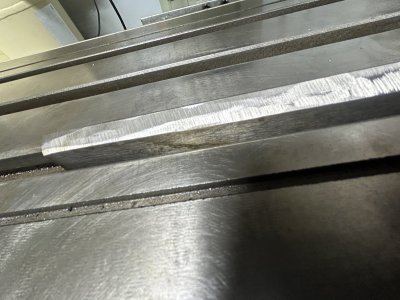 IMG_2347.jpeg460 KB · Views: 18
IMG_2347.jpeg460 KB · Views: 18 -
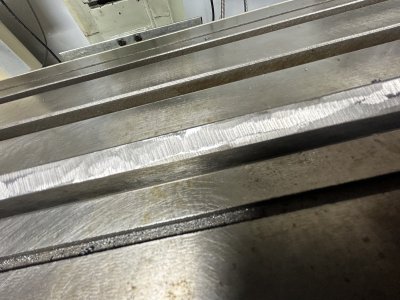 IMG_2348.jpeg537.1 KB · Views: 18
IMG_2348.jpeg537.1 KB · Views: 18 -
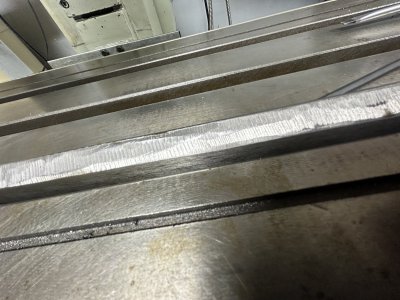 IMG_2349.jpeg530.3 KB · Views: 17
IMG_2349.jpeg530.3 KB · Views: 17 -
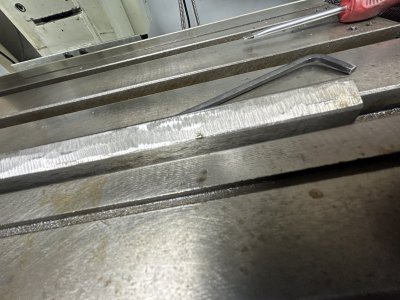 IMG_2350.jpeg508.1 KB · Views: 17
IMG_2350.jpeg508.1 KB · Views: 17 -
 IMG_2351.jpeg394.2 KB · Views: 16
IMG_2351.jpeg394.2 KB · Views: 16 -
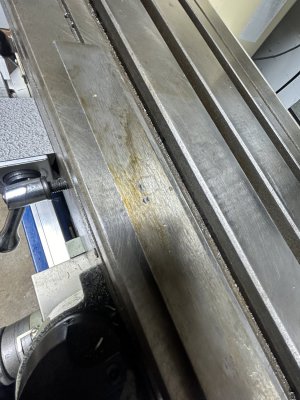 IMG_2352.jpeg347.3 KB · Views: 15
IMG_2352.jpeg347.3 KB · Views: 15 -
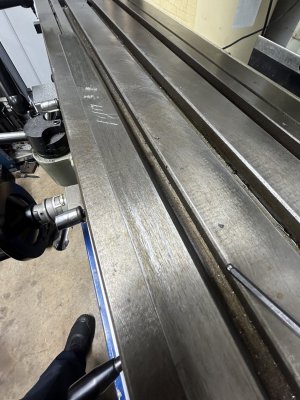 IMG_2353.jpeg364.2 KB · Views: 12
IMG_2353.jpeg364.2 KB · Views: 12 -
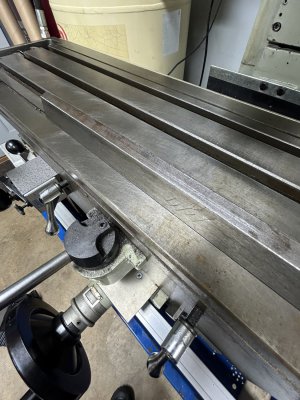 IMG_2354.jpeg371.4 KB · Views: 17
IMG_2354.jpeg371.4 KB · Views: 17
- Joined
- Dec 26, 2015
- Messages
- 2,151
Yes, sure I have. That's why I recommend pulling the gib, inspecting and stoning it for burrs. I don't know which machine you have. Here are some good videos on gib adjustment/alteration:Take a look at this gib and tell me if you have ever seen one made so crappy. I ran out of gib adjustment so I pulled the gib out and this is what I find. This machine has less than 20 hours I would say. It is a Chinese piece of ****, no doubt but wow
There are a couple types of polymer products for repairing or upgrading l ways and mating elements. the Moglice I mentioned is an epoxy liquid that flows or can be formed with a trowel/scraper during application. I have not seen anyone try to resurface a pitted or gouged gib with Moglice, but it's an interesting idea.Yes sir, I believe I can find all the info I need with what you have provided. If by chance I get in over my head, I know where to find you. I’ve never worked in with Moglice. Is that the same epoxy based stuff for restoring the ways on a lathe bed? I am in the process of restoring a Harig 618 surface grinder and I have some galling on the y axis ways of that machine and I’ve been kind of wondering what I could use to at the very least, fill the Pitts. I will do some research on that as well. Thank you
There are sheet-type products such as Turcite B and Rulon for more serious work where you need to increase height to replace worn or ground-away surfaces that slide and mate. This type of product needs a special glue to affix it to metal surfaces, but it can be scraped in a conventional manner. Example:
5/10ths should be ideal for this. A tenths indicator will drive you wild.Also when checking my gib adjustment with an indicator, would it be ok to use a 1 tenths? Or a 5 tenths indicator ? Which would be best?
I really appreciate all your help. That gib turned my stomach. May try shimming it to see what happens. The problem is I bottom the screw out on the tightening end but I can stil shove the gib further to take out the slop. It’s almost like the gib was cut too short. It’s a piece of crap Bolton zx45aYes, sure I have. That's why I recommend pulling the gib, inspecting and stoning it for burrs. I don't know which machine you have. Here are some good videos on gib adjustment/alteration:
There are a couple types of polymer products for repairing or upgrading l ways and mating elements. the Moglice I mentioned is an epoxy liquid that flows or can be formed with a trowel/scraper during application. I have not seen anyone try to resurface a pitted or gouged gib with Moglice, but it's an interesting idea.
There are sheet-type products such as Turcite B and Rulon for more serious work where you need to increase height to replace worn or ground-away surfaces that slide and mate. This type of product needs a special glue to affix it to metal surfaces, but it can be scraped in a conventional manner. Example:
that
5/10ths should be ideal for this. A tenths indicator will drive you wild.
- Joined
- Dec 18, 2022
- Messages
- 2,688
I bought these shims from Amazon and found them to work great.Well, I don't know about "guru", but perhaps "battle scared" is a better reference here - with missing finger to prove it. LOL
Click here to view a short write-up I prepared on tramming and aligning the column of a benchtop mill. The last two paragraphs include links to two specific videos I think are excellent - one dealing with shimming the column/base connection, the other dealing with epoxy. Personally, I prefer the epoxy method, but I would not recommend it to anyone who hasn't worked with Moglice epoxy before. So with respect to this post, using shims is probably the best approach.
McMaster has plenty of options for shim material, but the thinnest is 0.001-inches, and depending on your level of OCD, thinner shims could be required. I use household aluminum foil (0.0006") and cigarette paper (which will compress to 0.0003") to get super precise final adjustment. You'd be surprised how much 0.0005" under the column will tilt the top of the benchtop mill column. Now, I will admit to having an OCD level of permandently set to 11 on the scale.
I have posted about aligning the column on a benchtop mill several times on H-M. Just search the word "column" with my user name (davidpbest). Here are a few highlights:

PM833TV alignment question
Dan, you are correct that shimming the column is not best practice. You could either scrape the column to base surfaces (tons of work) or you could epoxy the connection, which is what I did on my RF-45. That process is well described at this video: My guess is that you will need shims that...www.hobby-machinist.com

Tramming my PM-833TV
All of my experience in the past was on full size Bridgeport mills. I'm discovering that these column bed type mills are a different animal as far as tramming goes. I've done some research but would like to hear from others the techniques they use. Here is what my gut and a little research...www.hobby-machinist.com
Hope this helps.
